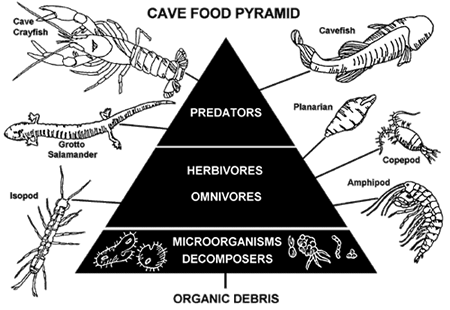at Onondaga Cave State Park
When food energy moves from the sun to a plant, to an animal, to another animal, that is a food chain. The fact that animals live in caves at all, proves that caves are not isolated from the surface. On the surface, all food chains start with green plants, which make food from sunlight. In a dark cave, there is no sunlight and no green plants. Thus, all food for the animals must come from outside, on the surface.
Food moves into the cave in two ways: it is washed in, or it is carried in by animals. Organic debris, such as leaves, sticks, dead animals and even logs can get washed down sinkholes or into cave entrances by flooding or heavy rains. The water that enters the cave every day, even without a flood or rain, may look clear, but it contains much dissolved organic matter.
Bats--The Base of the Food Pyramid
 |
|---|
Much of the food inside a cave is carried in by bats. Bats are mammals, and all of Missouri's bats eat insects. There are many fantastic tales about bats, and almost all of them are false. They are not aggressive and bite only in self-defense, just like any other wild animal. Our own pets are more dangerous and carry more diseases than bats do. Although bats can see very well, it is their echolocation that makes them special. Bats give out ultrasonic calls, which are too highly pitched for people to hear. By listening for the echoes of these calls, bats are able to find insects in the dark and to fly through dark caves. Thus, bats are one of the few predators on night flying insects, such as mosquitoes. Bats are important in the balance of nature both above and below ground.
Bats only roost in caves; they cannot stay there. Bats must leave the cave in order to hunt for insects (remember they are trogloxenes?). When they return, their droppings (guano) fall to the floor of the cave. Cave crickets, which also feed outside, add their guano and their eggs to the cave as well. In addition, other trogloxenes, such as raccoons, woodrats, etc., leave behind their feces and nesting materials. Also, should any of these animals die within the cave, their bodies become part of the food supply.
How is the Pyramid Built?
Fungus and microscopic decomposers feed on and break down the organic material that accumulates in caves. They are the next link in the food chain. Although some animals can feed on guano directly, most depend on these decomposers for food. Millipedes and tiny crustaceans feed on the fungus and microbes. Cave beetles prey on these animals and eat the eggs of cave crickets. Cave spiders and centipedes are also predators in the cave ecosystem. Salamanders and cavefish may seem too small to be top carnivores in a food chain, but there is not much food in caves to begin with. With each link in the food chain, there is less food energy available for the next link because some energy is lost in each transfer, a result of the laws of thermodynamics. Thus, there are more animals and fungi at the base of the food chain, than at its top. If we make each link of the chain as wide as its numbers, we get what is called a food pyramid with many decomposers at the base and only a few large carnivores at the top.

Limiting Factors
 |
|---|
The distribution and abundance of animals within a cave are determined by three main limiting factors: food supply, temperature and humidity. The lack of food has obvious consequences. Temperature is also important. Everything works well at a relatively constant cool temperature. However, fluctuating higher temperatures cause problems for cave animals. For example, during its history, Onondaga Cave has had nine artificial openings made into it. This has caused many unnatural drafts. These drafts cause higher temperatures in the summer, raising the metabolic rate of cold-blooded troglobites, increasing their need for food. Bats are extremely temperature sensitive animals and will abandon a cave if its temperature changes by as little as 2°F or 1°C. Furthermore, as the bat population declines, so does the guano, and therefore, the food supply for other animals. When the humidity drops, the drier conditions can harm salamanders, which breathe through a moist skin.






